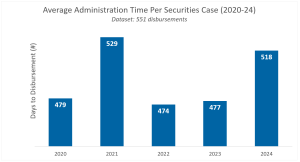[Report] Securities Class Action Administration: The Critical Process That Shapes Investor Recoveries
Every year, U.S. and Canadian securities class action settlements represent billions in compensation for eligible investors. The process for distributing these funds, known as claims administration, is pivotal in determining A) which investors are owed compensation, and B) how much they should receive.
Recent, high-profile cases of bad actors obtain recovery funds through fraudulent means have put settlement administration firms responsible for fund distribution under greater pressure to scrutinize high-value claims and their supporting documentation more closely. At the same time, these firms also feeling the heat from class counsel and courts to process settlements in a timely fashion.
The result: more document audits and shorter response windows for claimants to address deficiencies, both of which present challenges for investors that lack robust recovery programs.

FRT’s proprietary recovery database bears these trends out. In 2024, the average case administration time rose to 518 days, an 8.5% increase from the prior year. Additionally, the volume of documentation audits our team managed in U.S. and Canadian securities class actions more than doubled from 2023-24.
Investors leave eligible dollars on the table if their claims do not survive the administration process. Understanding how settlement administration firms prefer to operate, and which trends shape their work today, can help investors improve their odds of receiving payment on valid claims.
FRT’s latest market report, “Why Securities Class Action Administration Matters,” examines this critical process shaping settlement distributions and payout rates. We hope these insights can help investors better future-proof their class action recovery programs in 2025.




